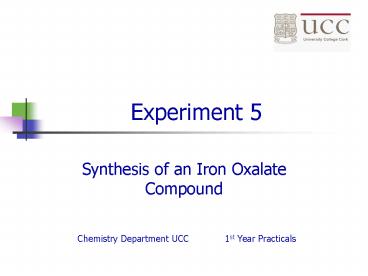Experiment 5 PowerPoint PPT Presentation
1 / 25
Title: Experiment 5
1
Experiment 5
Synthesis of an Iron Oxalate Compound
Chemistry Department UCC 1st Year Practicals
2
Objectives
- To gain further experience of synthetic inorganic
chemistry - To learn about reduction-oxidation (redox)
titrations - To characterise the synthesised iron oxalate
compound
3
Background
- Much of inorganic chemistry involves the
preparation and characterisation of compounds - Ferrous ammonium sulphate and oxalic acid
dihydrate are reacted in aqueous solution - Oxalate ion is generated and binds to the ferrous
ion to produce an insoluble compound - Ammonium and sulphate ions remain in solution
4
Water of crystallisation
- Both ferrous ammonium sulphate and oxalic acid
are prepared using excess water - On evaporation crystals form that trap water
molecules in solid compounds - These are hydrated compounds
- Iron oxalate is hydrated
5
Background
- NH42FeSO42.6H2O H2O ? 2NH4aq
2SO42-aq Fe2aq - H2C2O4.2H2O H2O ? 2Haq C2O42-aq
- Fe2aq C2O42- ? FeC2O4. 2H2O
6
Synthesis of Iron Oxalate
- In a 250 mL beaker add 3.75 g of ferrous ammonium
sulphate to 30 ml of water that has been
acidified with 5 mL of dilute H2SO4 - Add a solution of oxalic acid in 40 mL of water
- Heat to boiling yellow ppt will form
- Decant the supernatant solution
7
Synthesis of Iron Oxalate
- Add 30 mL of warm water to the ppt
- Filter the ppt on the Buchner funnel and flask
- The yellow compound is hydrated iron oxalate
- Record the mass isolated and divide your sample
in two (Exp. 6c)
8
Report
- Exerimental results
- Observations
- Balanced reaction equations
- Calculations
- Make sure you keep some sample for experiment 6c
9
Experiment 6
- Reduction-Oxidation Titrations
10
Objectives
- Learn about reduction-oxidation (redox)
titrations - Use techniques learned to characterise the Iron
Oxalate compound synthesized in Experiment 5 - Become familiar with calculation of degree of
hydration
11
Background
- In redox titrations permanganate MnO4- is one
of the most important reagents (MnVII) - Can be reduced in acidic solution to give the
manganous ion Mn2 - MnO4- 8H 5e- ? Mn2 4H2O
- One mole of permanganate gains 5e-
12
Background
- Reduction must be balanced by oxidation
- Permanganate gains 5e-
- 5e- must also be lost
- 5 atoms of Fe2 can be oxidised to Fe3
- MnO4- 8H 5Fe2 ? Mn2 4H2O 5Fe3
13
Background
- Oxalic acid can also be oxidized by permanganate
- Oxalic acid is converted to carbon dioxide gas
and 2 electrons are released - 2MnO4- 5C2O42- 16H ? 2Mn2 10CO2 8H2O
14
Indicators
- The permanganate ion MnO4- is purple in colour
- A drop of excess MnO4- will result in a solution
pink in colour - No indicator is required self indicating
- Colourless ? Pink
- Acidification is important for colour change
15
Experiment 6a
- Titrating ferrous ammonium sulphate against
potassium permanganate - Know KMnO4 concentration, calculate the ferrous
ammonium sulphate concentration in M and gL-1 - KMnO4 in the burette
- Iron salt and dilute acid in the conical flask
16
Experiment 6b
- Titrating oxalic acid against potassium
permanganate - Titration solution heated to accelerate reaction
- Oxalic acid solution, water, and dilute acid in
conical flask heat to 80 C - KMnO4 in the burette
- Calculate oxalic acid conc. in M and gL-1
17
Experiment 6c
- Determining the degree of hydration of the salt
synthesized in Exp 5 - Titrating Iron Oxalate against permanganate
- Heat the titration solution
- Perform the titration in the same manner as 6b
18
Calculations
- App. Mol Mass FeC2O4144 g mol-1
- 3KMnO4 5FeC2O4 24H 15e- ? 3Mn2 5Fe3
10CO2 12H2O 15e- - Calculate the no. moles FeC2O4 from titration
value
19
Calculations
- Calculate actual molecular mass of FeC2O4.XH2O
from the equation - No. of g no. of moles x Mol mass
- actual mol mass apparent mol mass mol mass of
the water in the hydrated salt - Divide this number by 18 (MW of H2O) to get the
value of X
20
Report
- All observations
- All your results
- All calculations
- Questions in the manual
- Exp 5 and Exp 6a today, 6b 6c next week
- No pre-practical talk next week
21
Experiment 7
- Molecular Structure
22
Objectives
- Use the periodic table
- Draw Lewis Structures of covalent molecules
- Use VSEPR theory to deduce the shape of molecules
- Determine the hybridisation of atoms in covalent
molecules
23
- Determine the Lewis Structure, molecular
structure and hybridisation of the central atom
in each of - CF4, SF4, NH4, NH3, NH2-, SF6, PF5, BeCl2, BF3,
Cl2O, PO43-, SO2 - Answer the questions in the manual
24
Example CF4
- C 4 valence electrons
- F 4 x 7 valence electrons 28e-
- 32e- in total
- 8e- in bonding, 24e- to distribute
- Identify shape hybridisation
25
Report
- Do this for each compound
- Answer the questions
- Use your model kit when deducing the 3D shape of
the molecules - Hand up to your demonstrators the 1st session
after the holidays

